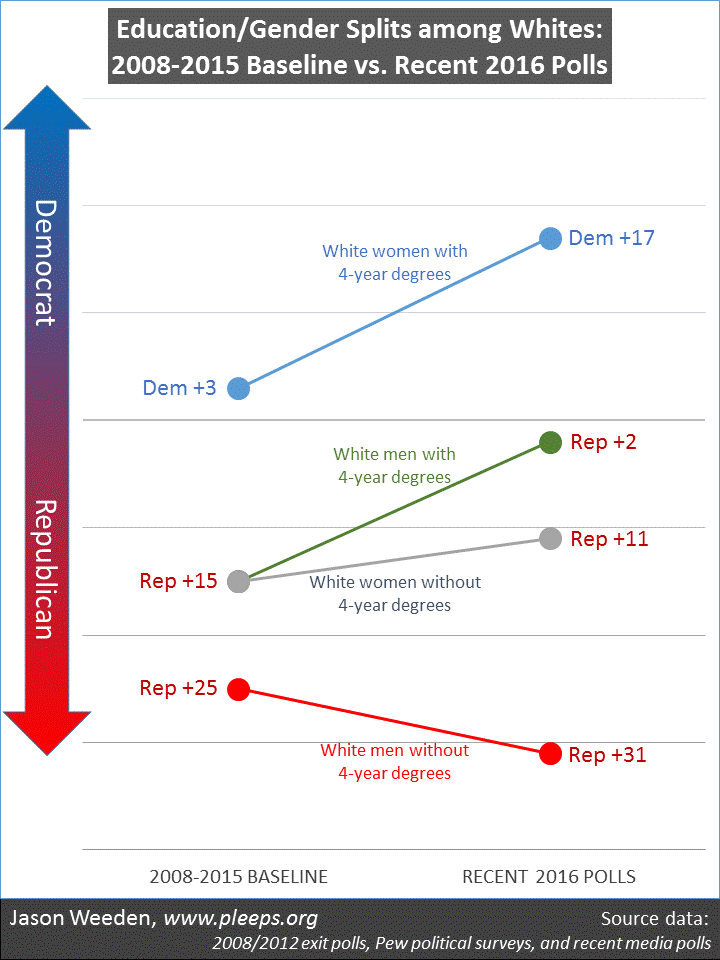Based on my analysis of recent polls, the current presidential election looks likely to produce at least two big movements among white voters in comparison with the Obama era: (1) a shift to the left for whites with 4-year degrees (both women and men) and (2) a widened gender gap for whites without 4-year degrees.
The chart below shows how things are shaping up for four demographic groups—white women with degrees, white men with degrees, white women without degrees, and white men without degrees. The 2008-2015 baseline is an average of information from the 2008 and 2012 presidential exit polls as well as party identification data from those likely registered to vote in Pew political surveys from Jan. 2013 to Jan. 2016. The recent 2016 poll numbers combine information from seven presidential polls (ABC, Qunnipiac, two Fox, CBS, ABC/WaPo, and NBC/WSJ) from the past couple of weeks, three of which reported responses for the exact demographic groups in the chart, and the other four of which reported responses for whites without degrees, whites with degrees, women, and men, which I used to estimate the demographic groups in the chart.
In the Obama years, white women with degrees favored Democrats by around 3 points. White men without 4-year degrees, in contrast, favored Republicans by around 25 points. The other two groups—white women without degrees and white men with degrees—were in between, with both favoring Republicans by around 15 points.
In recent presidential election polls, whites with college degrees—both women and men—have shifted substantially from their prior baselines. Rather than favoring Democrats by around 3 points, white women with degrees have recently polled in favor of Clinton over Trump by around 17 points (a 14-point shift). And rather than favoring Republicans by around 15 points, white men with degrees have recently polled in favor of Trump over Clinton by only around 2 points (a 13-point shift). The similar-sized shifts suggest that the current election might not appreciably expand the partisan gender gap among degreed whites.
In contrast, among whites who lack 4-year degrees, women and men have smaller shifts but a substantially widened gender gap. White women without degrees have moved around 4 points to the left while white men without degrees have moved around 6 points to the right. Prior to the current election, the gender gap among degreed whites was larger than among non-degreed whites; in recent polls, however, primarily due to the widened split for non-degreed whites, both groups show around 20-point gender gaps.
As always, take the exact numbers with a grain of salt. In particular, the current polling numbers are estimates based on somewhat complex analyses of relatively small subsamples. And there remains much that we do not yet know, including the real possibility that this election might involve unusual patterns of turnout, which could betray to some degree the “likely voter” models used by some pollsters.
While the education and gender patterns of whites are drawing a lot of attention this year—for good reason—there’s lots of other interesting stuff to watch out for. One set I’ll be checking out will be how these education/gender shifts relate to current religious splits among whites. For example, are we seeing these education/gender shifts across the religious spectrum, or is it concentrated, say, among Catholics and non-evangelical Protestants? Sorting that out with any confidence will take really large samples, which won’t become publicly available until well after the election.
And of course there are plenty of other things to look out for as well. How is income factoring in? How will the new split between Mormons and white evangelical Protestants—who looked politically very similar to each other prior to this election—pan out and what will that really involve? Will Latinos and Asians differ markedly from recent elections, and how will immigrants and the native-born differ? How are all these various demographic shifts affecting regional patterns? To what extent will we see major changes in party identification in addition to cross-party voting (or people just sitting this election out), and, in a related vein, will ticket-splitting make a comeback? And so on. Really, I’m just looking forward to poking around big datasets after this election, knowing that it won’t be the same old same old.

